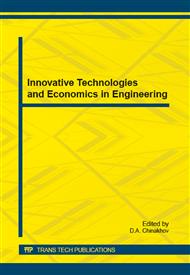[1]
Godet М. Reducing the Blunders in Forecasting / Futures, 1983. — 15, № 3. — P. 181–192.
DOI: 10.1016/0016-3287(83)90164-7
Google Scholar
[2]
Cohen, W. (1996). Empirical studies of innovative activity,. in P. Stoneman (ed. ), The Handbook of the Economics of Technological Change, Oxford: Basil Blackwell, 182-264.
Google Scholar
[3]
Rybina G.V. Bases of intellectual systems construction. – M.: Finansy i statistika; INFRA-M, 2010. 432 p.
Google Scholar
[4]
Rowe, Gene & Wright, George (2001). Expert opinions in forecasting: The role of the Delphi technique, In: J. S. Armstrong (Ed. ), Principles of Forecasting. Boston: Kluwer Academic Publishers.
Google Scholar
[5]
Nesteruk D.N. Monitoring of innovative activity efficiency / Kreativnaya ekonomika. – 2010. - #2 – P. 62-67.
Google Scholar
[6]
Momot M.V., Nesteruk D.N. Gathering and processing the expert data using web-centric system / Gornoe mashinostroenie: Sbornik materialov. Otdel'nyi vypusk Gornogo informacionno-analiticheskogo byulletenya (nauchno-tehnicheskogo zhurnala). – 2011. - #OV2. – 488p. – M.: izdatel'stvo «Gornaya kniga». P. 330-335.
Google Scholar
[7]
Korikov A.M., Nesteruk D.N. Estimation of innovative projects efficiency in mechanical engineering / Doklady Tomskogo gosudarstvennogo universiteta sistem upravleniya i radioelektroniki, #2 (24), v. 3, 2011, P. 142-147.
Google Scholar
[8]
U. S. Environmental Protection Agency. 1998. Guidelines for Ecological Risk Assessment. Published on May 14, 1998, Federal Register 63(93): 26846-26924. Washington, D.C.: U. S. Environmental Protection Agency.
Google Scholar
[9]
J. Scott Armstrong. The Forecasting Canon: Nine Generalizations to Improve Forecast Accuracy / International Journal of Applied Forecasting, Vol. 1, pp.29-35, June (2005).
Google Scholar
[10]
Rothwell R. Towards the fifth-generation innovation process / International Marketing Review, Vol. 11 No. 1, 1994. MCB University Press, pp.7-31.
Google Scholar


